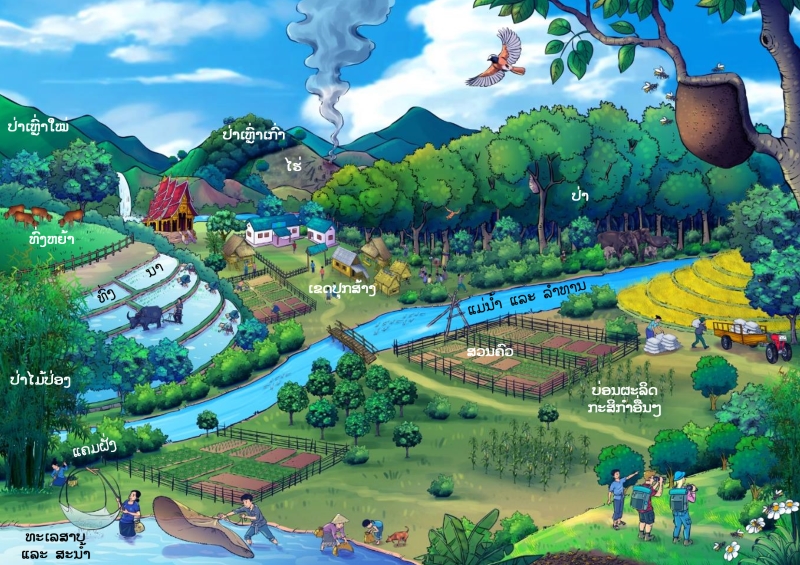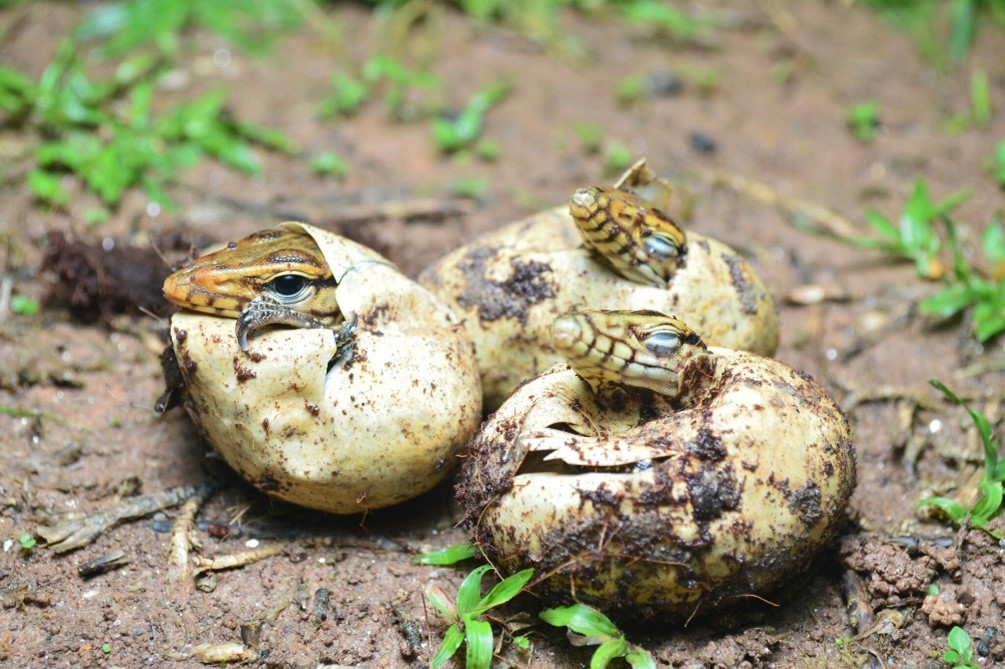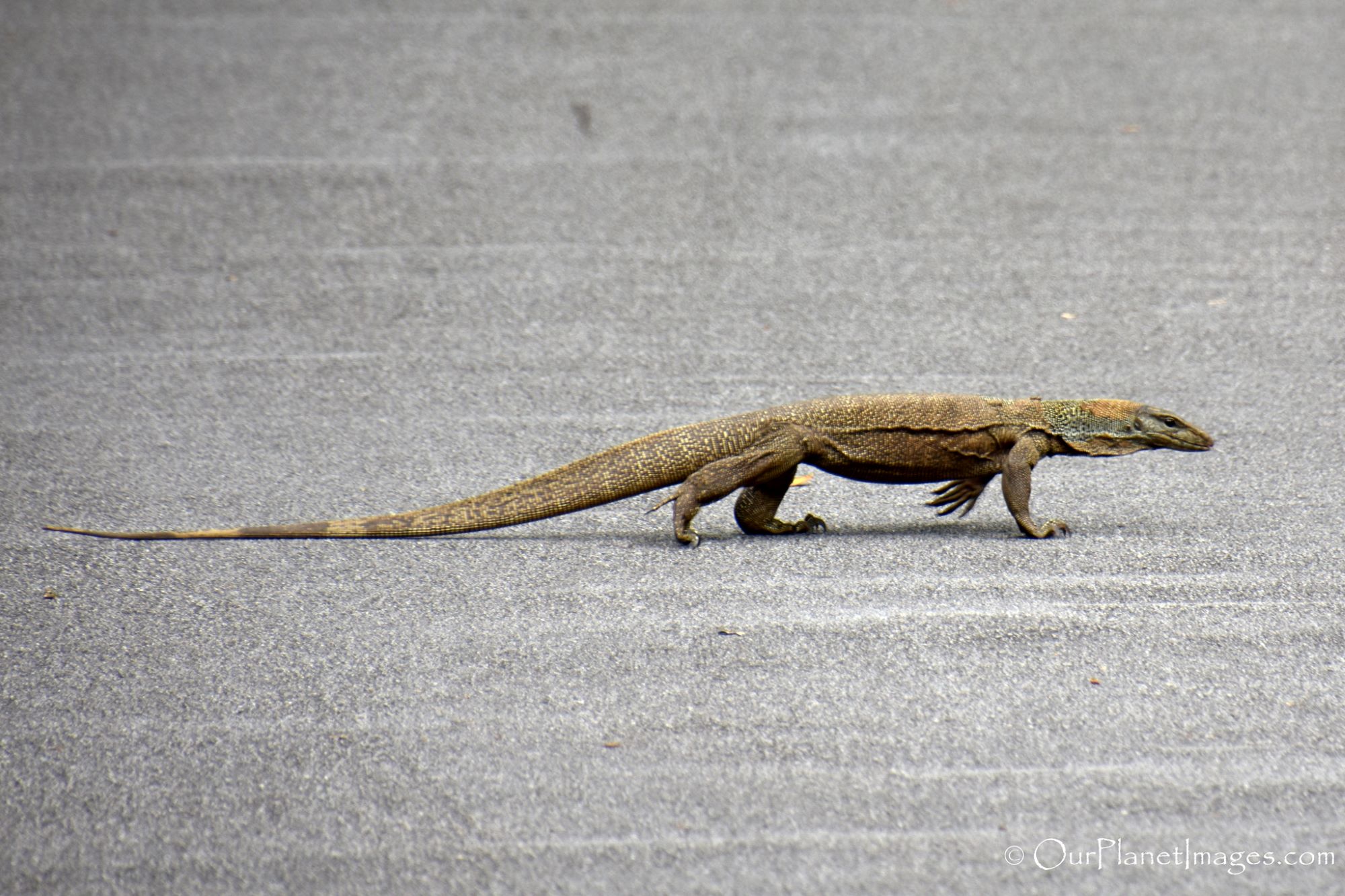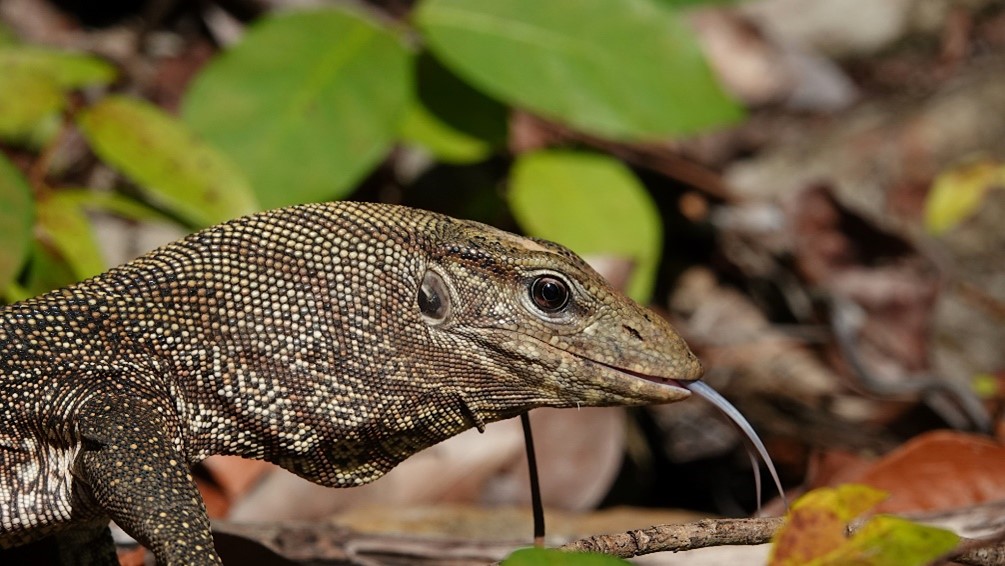ເລກລຳດັບທີ: 3846
ລະດັບການຮວບຮວມຂໍ້ມູນ: ເກີອບສົມບູນ
ປັບປູງຄັ້ງລ່າສຸດ: 2024-10-11
ແລນ
Bengal Monitor
Varanus nebulosus (GRAY, 1831)
ສັດ
ສັດເລືອຄານ
ສັດເລືອຄານ
×
ຊື່ທ້ອງຖີ່ນ:
ໂຕແລນ, ນາກາເດ້ (ມົ້ງ) ( Clouded Monitor)
ຊື່ພ້ອງ
:
Monitor nebulosus Gray, 1831
Varanus bengalensis subsp. nebulosus (Gray, 1831)
Varanus bengalensis subsp. vietnamensis Yang & Liu, 1994
Varanus vietnamensis Yang & Liu, 1994
Varanus bengalensis subsp. nebulosus (Gray, 1831)
Varanus bengalensis subsp. vietnamensis Yang & Liu, 1994
Varanus vietnamensis Yang & Liu, 1994
ຊື່ສະກຸນ:
Bengal monitor lizard
ຊະນິດໃກ້ຄຽງ:
ບັນຍາຍລັກສະນະທາງພືດສາດ:
ສັດຊະນິດນີ້ມີຂະຫນາດໃຫ່ຍ ແລະ ມີລັກສະນະເດັ່ນຄືຫົວ, ຂາ ແລະ ຫາງ. ຫາງມີຄວາມໂດດເດັ່ນເພາະວ່າມີຄວາມຍາວກວ່າຄວາມຍາວມາດຕະຖານຂອງຮ່າງກາຍ (SVL) ປະມານ 1.5 ເທົ່າ. ມີຮູບຮ່າງທີ່ເປັນເອກະລັກທີ່ແປໄປດ້ານຂ້າງໂດຍກະດູກດ້ານເທິງງໍ ເຊິ່ງຊ່ວຍໃນການເຄື່ອນໄຫວ.
ເກັດຫາງແມ່ນຫນ້າສົນໃຈເຊັ່ນດຽວກັນ; ເກັດຂ້າງ (ທີ່ຢູ່ດ້ານຂ້າງ) ແມ່ນນ້ອຍກວ່າເກັດທີ່ຢູ່ຂ້າງລຸ່ມ. ຄວາມແຕກຕ່າງຂະຫນາດເກັດຂອງມັນຂ້ອນຂ້າງເປັນສິ່ງທີ່ແປກ.
ຫົວຂອງສັດສາຍພັນນີ້ມີລັກສະນະເດັ່ນບາງປະການ, ເກັດຢູ່ເທິງດວງຕາມີຂະຫນາດໃຫ່ຍ ເຮັດໃຫ້ເຫັນໄດ້ຊັດເຈນ ຮູດັງມີຮູບຊົງເປັນຮູ ເຊິ່ງເປັນລັກສະນະສຳຄັນໃນການລະບຸຕົວຕົົນຫຼັກ ເຖິ່ງແມ່ນວ່າພວກມັນຈະມີລັກສະນະກົມໃນຕອນຍັງນ້ອຍກໍຕາມ. ຮູດັງຈະຢູ່ລະຫວ່າງຕາ ແລະ ປາຍດັງ ເຊິ່ງມັກຈະນູນອອກມາ ໂດຍສະເພາະໃນບັນດາໂຕທີ່ຂະຫຍາຍຕົວເຕັມທີແລ້ວ. ຢູ່ຕາມທ້ອງ, ມີເກັດ 70 ຫາ 90 ແຖວທີ່ຍາວຕັ້ງຄໍຈົນຮອດຂອບດ້ານໜ້າຂອງຂາຫຼັງ ການຈັດລຽງເກັດດັງກ່າວມີຄວາມສຳຄັນຕໍ່ຄວາມເຂົ້າໃຈກ່ຽວກັບ ໂຄງສ້າາງຂອງຊະນິກພັນ ແລະ ຍັງສາມາດຊ່ວຍຈຳແນກຊະນິດພັນໃນພາກສະໜາມໄດ້.
ຂະຫນາດ ແລະ ອາຍຸທີ່ພ້ອມປະສົມພັນ: ຂະຫນາດນ້ອຍກ່ວາ 22.5 ( ຫລື 28.9) ຊມ. ຄວາມຍາວແຕ່ປາຍດັງຫາກົ້ນ (SVL), ໂດຍທຳມະຊາດ ເມື່ອອາຍຸ 2.5 ຫາ 3 ປີ ຈະອອກໄຂຄັ້ງລະ 9 ຫາ 27 ຟອງ, ຂື້ນຢູ່ກັບຂະໜາດຂອງເພດແມ່, ປີໜຶ່ງຈະຫວ່າງໄຂ 1 ຫາ 2 ຄັ້ງ.
ວົງຈອນຊີວິດ: ຕອນກາງເວັນມັກຈະອາໄສຢູ່ຕາມພື້ດິນເປັນຫຼັກ ກິນສັດທີ່ບໍ່ມີກະດູກສັນຫຼັງເປັນອາຫານເຊັ່ນວ່າ: ແມງມຸມ ແລະ ແມງງອດ.
ແຫຼ່ງທີ່ມາ: [4]
ເກັດຫາງແມ່ນຫນ້າສົນໃຈເຊັ່ນດຽວກັນ; ເກັດຂ້າງ (ທີ່ຢູ່ດ້ານຂ້າງ) ແມ່ນນ້ອຍກວ່າເກັດທີ່ຢູ່ຂ້າງລຸ່ມ. ຄວາມແຕກຕ່າງຂະຫນາດເກັດຂອງມັນຂ້ອນຂ້າງເປັນສິ່ງທີ່ແປກ.
ຫົວຂອງສັດສາຍພັນນີ້ມີລັກສະນະເດັ່ນບາງປະການ, ເກັດຢູ່ເທິງດວງຕາມີຂະຫນາດໃຫ່ຍ ເຮັດໃຫ້ເຫັນໄດ້ຊັດເຈນ ຮູດັງມີຮູບຊົງເປັນຮູ ເຊິ່ງເປັນລັກສະນະສຳຄັນໃນການລະບຸຕົວຕົົນຫຼັກ ເຖິ່ງແມ່ນວ່າພວກມັນຈະມີລັກສະນະກົມໃນຕອນຍັງນ້ອຍກໍຕາມ. ຮູດັງຈະຢູ່ລະຫວ່າງຕາ ແລະ ປາຍດັງ ເຊິ່ງມັກຈະນູນອອກມາ ໂດຍສະເພາະໃນບັນດາໂຕທີ່ຂະຫຍາຍຕົວເຕັມທີແລ້ວ. ຢູ່ຕາມທ້ອງ, ມີເກັດ 70 ຫາ 90 ແຖວທີ່ຍາວຕັ້ງຄໍຈົນຮອດຂອບດ້ານໜ້າຂອງຂາຫຼັງ ການຈັດລຽງເກັດດັງກ່າວມີຄວາມສຳຄັນຕໍ່ຄວາມເຂົ້າໃຈກ່ຽວກັບ ໂຄງສ້າາງຂອງຊະນິກພັນ ແລະ ຍັງສາມາດຊ່ວຍຈຳແນກຊະນິດພັນໃນພາກສະໜາມໄດ້.
ຂະຫນາດ ແລະ ອາຍຸທີ່ພ້ອມປະສົມພັນ: ຂະຫນາດນ້ອຍກ່ວາ 22.5 ( ຫລື 28.9) ຊມ. ຄວາມຍາວແຕ່ປາຍດັງຫາກົ້ນ (SVL), ໂດຍທຳມະຊາດ ເມື່ອອາຍຸ 2.5 ຫາ 3 ປີ ຈະອອກໄຂຄັ້ງລະ 9 ຫາ 27 ຟອງ, ຂື້ນຢູ່ກັບຂະໜາດຂອງເພດແມ່, ປີໜຶ່ງຈະຫວ່າງໄຂ 1 ຫາ 2 ຄັ້ງ.
ວົງຈອນຊີວິດ: ຕອນກາງເວັນມັກຈະອາໄສຢູ່ຕາມພື້ດິນເປັນຫຼັກ ກິນສັດທີ່ບໍ່ມີກະດູກສັນຫຼັງເປັນອາຫານເຊັ່ນວ່າ: ແມງມຸມ ແລະ ແມງງອດ.
ແຫຼ່ງທີ່ມາ: [4]
ນິເວດວິທະຍາ
ເຂດກະຈາຍພັນທົ່ວໂລກ:
Native to Afghanistan, Bangladesh, Cambodia, China (Yunnan), India (Tamil Nadu, Kerala, Jammu-Kashmir, Himachal Pradesh, Assam, Madhya Pradesh, Gujarat), Indonesia (Jawa), Iran, Islamic Republic of, Lao People's Democratic Republic, Malaysia, Myanmar, Nepal, Pakistan, Sri Lanka, Thailand, Viet Nam, Indonesia.
Distribution area between 1896 and 2024. Source: [5]
Distribution area between 1896 and 2024. Source: [5]
ເຂດກະຈາຍພັນໃນລາວ
:
ເຂດພູສູງພາກເໜືອຂອງລາວ
ລຽບແມ່ນ້ຳຂອງພາກເໜືອ
ເຂດພູສູງສາຍພູຫຼວງ ແລະ ເຂດພູພຽງແຂວງຊຽງຂວາງ
ທົ່ງພຽງວຽງຈັນ
ເຂດສາຍພູຫຼວງພາກເໜືອ
ເຂດສາຍພູຫຼວງຕອນລຸ່ມ
ສາຍພູຫຼວງພາກໃຕ້
ເຂດລຽບແມ່ນ້ຳຂອງພາກໃຕ້
ພູພຽງບໍລິເວນ
ເຂດສາຍພູຫຼວງພາກກາງ
ລຽບແມ່ນ້ຳຂອງພາກເໜືອ
ເຂດພູສູງສາຍພູຫຼວງ ແລະ ເຂດພູພຽງແຂວງຊຽງຂວາງ
ທົ່ງພຽງວຽງຈັນ
ເຂດສາຍພູຫຼວງພາກເໜືອ
ເຂດສາຍພູຫຼວງຕອນລຸ່ມ
ສາຍພູຫຼວງພາກໃຕ້
ເຂດລຽບແມ່ນ້ຳຂອງພາກໃຕ້
ພູພຽງບໍລິເວນ
ເຂດສາຍພູຫຼວງພາກກາງ

ເຂດກະຈາຍພັນຕາມພູມສັນຖານ
:
ປ່າປູກ
ປ່າປະສົມປ່ຽນໃບ
ປ່າໂຄກ
ປ່າແປກປະສົມປ່າໃບກ້ວາງ
ປ່າເຫຼົ່າແກ່
ແຄມຝັ່ງນໍ້າ
ໜອງບຶງ ແລະ ດິນຖານຕົມ
ປ່າປະສົມປ່ຽນໃບ
ປ່າໂຄກ
ປ່າແປກປະສົມປ່າໃບກ້ວາງ
ປ່າເຫຼົ່າແກ່
ແຄມຝັ່ງນໍ້າ
ໜອງບຶງ ແລະ ດິນຖານຕົມ

ສະເພາະຖິ່ນໃນລາວ:
ສະເພາະຖິ່ນໃນລາວ
ຮຸກຮານ
:
ບໍ່ຮຸກຮານ
ສະຖານະພາບການອະນູຮັກ IUCN
:
ໃກ້ຖືກຄຸກຄາມ
ສະຖານະພາບການອະນຸຮັກແຫ່ງຊາດລາວ
:
ບັນຊີທີ່ I: ຊະນິດພັນປະເພດຫວງຫ້າມ
ການນຳໃຊ້
ປະເພດການນຳໃຊ້:
ຫ້າມນຳໃຊ້
ບັນຍາຍການນຳໃຊ້:
ຊະນິດນີ້ແມ່ນຖືກຂົ່ມຂູ່ ຫຼື ເປັນສັດຫວງຫ້າມເດັດຂາດໃນລາວ. ດັ່ງນັ້ນ, ທີມງານ PKL ແນະນຳໃຫ້ຢຸດການນຳໃຊ້ສາຍພັນທີ່ຢູ່ໃນປ່າ ເຊັ່ນດຽວກັນກັບການຊື້ຢູ່ໃນຕະຫຼາດ ຫຼື ການນໍາໃຊ້ພາກສ່ວນໃດໜຶ່ງຂອງມັນ, ຍົກເວັ້ນວ່າຊະນິດພັນດັ່ງກ່າວໄດ້ຖືກລ້ຽງ ແລະ ສິ້ນສ່ວນທີ່ຊື້ມານັ້ນມາຈາກການລ້ຽງ
ການປູກ ການລ້ຽງ:
ຊະນິດທຳມະຊາດ
ລະດູການເກັບກູ້:
ມິຖຸນາ
ກໍລະກົດ
ສິງຫາ
ກັນຍາ
ກໍລະກົດ
ສິງຫາ
ກັນຍາ
ການຕະຫຼາດ ແລະ ຕ່ອງໂສ້ມູນຄ່າ:
ບໍ່ສາມາດເກັບກູ້ໄດ້
ການຄຸ້ມຄອງຈັດການ
ການອານຸລັກທີ່ຢູ່ອາໄສ (ຄວາມຕ້ອງການທີ່ຢູອາໄສ, ໄພຄຸກຄາມ, ການອານຸລັກ ແລະ ການພື້ນຟູ):
ໄພຄຸກຄາມທີ່ໃຫຍ່ທີ່ສຸດສຳຫຼັບສາຍພັນນີ້ແມ່ນການລ່າ ເນື່ອງຈາກພວກມນຖືກລ່າເພື່ອເກັບເອົາໜັງ ແລະ ຊີ້ນສຳຫຼັບປຸ່ງແຕ່ງອາຫານ ແລະ ເພື່ອເອົາໄຂມັນສຳຫຼັບໃຊ້ໃນທາງການຢາ. [5]
ການເກັບກູ້ແບບຍືຍຍົງ (ການປະເມີນຜົນກະທົບ, ເຄື່ອງມືການຫຼຸດຜົນກະທົບ)
ຊະນິດພັນນີ້ພົບເຫັນຢູ່ໃນປ່າສະຫງວນຫຼາຍແຫ່ງ ແລະ ໄດ້ຮັບການຄຸ້ມຄອງໂດຍກົດໝາຍຈາກຫຼາຍປະເທດລວມທັງປະເທດລາວ, ເນື່ອງຈາກປະຈຸບັນຢູ່ໃນສັດຫວງຫ້າມປເະພດ I ຂອງ CITES, ຫ້າມສົ່ງອອກຢ່າງຖືກກົດໝາຍ. [7]
ກົດໝາຍ ແລະ ນະໂຍບາຍ (ກົດໝາຍ ແລະ ນະໂຍບາຍທີ່ກ່ຽວຂ້ອງ)
ກົດໝາຍວ່າດ້ວຍສັດປ່າ (ສະບັບປັບປຸ່ງ). [8]
ຂໍ້ຕົກລົງວ່າດ້ວຍການຮອງຮັບເອົາບັນຊີສັດນ້ຳ ແລະ ສັດປ່າ ປະເພດຫວງຫ້າມ ຫຼື ບັນຊີທີ່ I ແລະ ປະເພດຄຸ້ມຄອງປະເພດທີ່ II. [7]
ໄພຄຸກຄາມທີ່ໃຫຍ່ທີ່ສຸດສຳຫຼັບສາຍພັນນີ້ແມ່ນການລ່າ ເນື່ອງຈາກພວກມນຖືກລ່າເພື່ອເກັບເອົາໜັງ ແລະ ຊີ້ນສຳຫຼັບປຸ່ງແຕ່ງອາຫານ ແລະ ເພື່ອເອົາໄຂມັນສຳຫຼັບໃຊ້ໃນທາງການຢາ. [5]
ການເກັບກູ້ແບບຍືຍຍົງ (ການປະເມີນຜົນກະທົບ, ເຄື່ອງມືການຫຼຸດຜົນກະທົບ)
ຊະນິດພັນນີ້ພົບເຫັນຢູ່ໃນປ່າສະຫງວນຫຼາຍແຫ່ງ ແລະ ໄດ້ຮັບການຄຸ້ມຄອງໂດຍກົດໝາຍຈາກຫຼາຍປະເທດລວມທັງປະເທດລາວ, ເນື່ອງຈາກປະຈຸບັນຢູ່ໃນສັດຫວງຫ້າມປເະພດ I ຂອງ CITES, ຫ້າມສົ່ງອອກຢ່າງຖືກກົດໝາຍ. [7]
ກົດໝາຍ ແລະ ນະໂຍບາຍ (ກົດໝາຍ ແລະ ນະໂຍບາຍທີ່ກ່ຽວຂ້ອງ)
ກົດໝາຍວ່າດ້ວຍສັດປ່າ (ສະບັບປັບປຸ່ງ). [8]
ຂໍ້ຕົກລົງວ່າດ້ວຍການຮອງຮັບເອົາບັນຊີສັດນ້ຳ ແລະ ສັດປ່າ ປະເພດຫວງຫ້າມ ຫຼື ບັນຊີທີ່ I ແລະ ປະເພດຄຸ້ມຄອງປະເພດທີ່ II. [7]
ໂພຊະນາການ
ຄຸນຄ່າທາງໂພຊະນາການ:
ບັນຍາຍຄຸນຄ່າທາງໂພຊະນາການ:
N/A
| ສານອາຫານ | /100g | ໝາຍເຫດ |
|---|---|---|
| ໂປຣຕີນ | N/A | N/A |
| ຄາໂບໄຮເດຣດ | N/A | N/A |
| ໄຂມັນ | N/A | N/A |
| ວິຕາມິນ | N/A | N/A |
| ແຮ່ທາດ | N/A | N/A |
| ເສັ້ນໄຍ | N/A | N/A |
ອ້າງອິງ
ເຄດິດຮູບພາບ:
Young Bengal Monitor. [1] iNaturalist [Online]. Uploaded on 1 June 2024 by: Ajak King.
Available: https://www.inaturalist.org/observations/219690584. [Accessed: 1 October 2024]
Full Body of Bengal Monitor. [2] iNaturalist [Online]. Uploaded on 24 September 2021 by: Cheongweei
Gan. Available: https://www.inaturalist.org/observations/95942809. [Accessed: 1 October 2024]
Header of Bengal Monitor. [3] iNaturalist [Online]. Uploaded on 6 March 2024 by: nickdobbs.
Available: https://www.inaturalist.org/observations/201393406. [Accessed: 1 October 2024]
Available: https://www.inaturalist.org/observations/219690584. [Accessed: 1 October 2024]
Full Body of Bengal Monitor. [2] iNaturalist [Online]. Uploaded on 24 September 2021 by: Cheongweei
Gan. Available: https://www.inaturalist.org/observations/95942809. [Accessed: 1 October 2024]
Header of Bengal Monitor. [3] iNaturalist [Online]. Uploaded on 6 March 2024 by: nickdobbs.
Available: https://www.inaturalist.org/observations/201393406. [Accessed: 1 October 2024]
ອ້າງອິງ:
[4] A. Auliya and B. Koch, " Visual Identification Guide to the Monitor
Lizard Species of the World (Genus Varanus)" *CITES*, 2020. [Online]. Available: file:///C:/Users/duang/Downloads/Auliya-Koch-2020.pdf. [Accessed: Oct. 1, 2024].
[5] Cota, M., Stuart, B.L., Grismer, L., Quah, E., Panitvong, N.,
Neang, T., Nguyen, N.S., Wogan, G., Lwin, K., Srinivasulu, C., Srinivasulu, B., Vijayakumar, S.P., Ramesh, M., Ganesan, S.R., Madala, M., Sreekar, R., Rao, D.-Q., Thakur, S., Mohapatra, P. & Vyas, R. 2021. Varanus bengalensis. The IUCN Red List of Threatened Species 2021: e.T164579A1058949. https://dx.doi.org/10.2305/IUCN.UK.2021-2.RLTS.T164579A1058949.en. [Accessed on 27 February 2024.]
[6] ກອງທຶນປົກປັກຮັກສາສິ່ງແວດລ້ອມ Environment Protection Fund
"ຂໍ້ຕົກລົງວ່າດ້ວຍການຮັບຮັບເອົາບັນຊີ ສັດນ້ຳ ແລະ ສັດປ່າ ປະເພດຫວງຫ້າມ ຫຼື ບັນຊີ I, II ແລະ III", 2022 [Online]. Available: https://shorturl.at/Wf1mp. [Accessed: Oct. 1, 2024].
[7] National Assembly of Lao PDR, "ກົດໝາຍວ່າດ້ວຍສັດປ່າ (ສະບັບປັບ
ປຸ່ງ)” 2023 [Online]. Available: https://shorturl.at/8L6OO. [Ac-cessed: Oct. 1, 2024].
Lizard Species of the World (Genus Varanus)" *CITES*, 2020. [Online]. Available: file:///C:/Users/duang/Downloads/Auliya-Koch-2020.pdf. [Accessed: Oct. 1, 2024].
[5] Cota, M., Stuart, B.L., Grismer, L., Quah, E., Panitvong, N.,
Neang, T., Nguyen, N.S., Wogan, G., Lwin, K., Srinivasulu, C., Srinivasulu, B., Vijayakumar, S.P., Ramesh, M., Ganesan, S.R., Madala, M., Sreekar, R., Rao, D.-Q., Thakur, S., Mohapatra, P. & Vyas, R. 2021. Varanus bengalensis. The IUCN Red List of Threatened Species 2021: e.T164579A1058949. https://dx.doi.org/10.2305/IUCN.UK.2021-2.RLTS.T164579A1058949.en. [Accessed on 27 February 2024.]
[6] ກອງທຶນປົກປັກຮັກສາສິ່ງແວດລ້ອມ Environment Protection Fund
"ຂໍ້ຕົກລົງວ່າດ້ວຍການຮັບຮັບເອົາບັນຊີ ສັດນ້ຳ ແລະ ສັດປ່າ ປະເພດຫວງຫ້າມ ຫຼື ບັນຊີ I, II ແລະ III", 2022 [Online]. Available: https://shorturl.at/Wf1mp. [Accessed: Oct. 1, 2024].
[7] National Assembly of Lao PDR, "ກົດໝາຍວ່າດ້ວຍສັດປ່າ (ສະບັບປັບ
ປຸ່ງ)” 2023 [Online]. Available: https://shorturl.at/8L6OO. [Ac-cessed: Oct. 1, 2024].
ຜູ້ສ້າງ Factsheet:
ຜູ້ກວດສອບ Factsheet:
,


